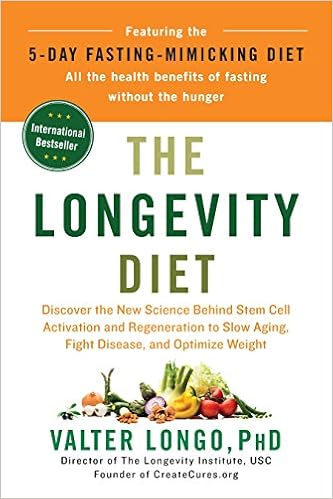
Many years ago I was interested in the concept of Calorie Restriction for improved lifespan. Theoretically you can extend your life by eating about 30% less than your normal calories. Anyway, that's the way it works, very reliably, in all kinds of animals, from single cell organisms, to worms, to mice. Primate experiments seem to show the same effect of increased lifespan.
I was interested, I read a few books (mainly Beyond the 120 Year Diet, by Roy Walford), but never actually reduced my calorie intake by 30%. It seemed too hard and uncomfortable.
Recently I've started listening to a podcast called Found My Fitness, by Rhonda Patrick. She interviews a lot of interesting researchers, and recently she interviewed Valter Longo, a scientist at the University of Southern California. He's done a lot of research, not on calorie restriction, but fasting, for periods of time of up to 5 days. Apparently mice who had the equivalent diet lived quite a bit longer than regular mice, and similar diets in humans lead to improved heath.
What Longo has developed is not a strict water fast, but a "fasting mimicking diet" of 5 days, where you eat between 30 and 50% of your normal calories. It's not a lot, but it's much easier than eating nothing. He developed the fasting mimicking diet after realizing that compliance with a water-only fast was very low, and people cheated a lot. He wrote it up in the book The Longevity Diet, published this year.
I decided to try it out, at least for one day.
I have fasted before. Once when I was in college I did a 3 day fast. My main recollections are that I got very tired—I needed to sit down on my walk to classes, and also when I actually started eating again, my mouth got a little sore from what I ate—I believe it was an apple. I guess your mouth loses it's toughness after you haven't eaten for a few days.
Then in the past year or so I tried just a day long fast, and it was not easy! It was uncomfortable, and I didn't feel good.
But I did want to try this "semi fast", and see how much easier it is if you eat just a little bit, instead of nothing. Longo has a commercial product that provides the appropriate amount of calories, but
I decided to just take the calorie count, and make my own DIY version.
I originally thought I'd do just one day. But then the first day was so easy that I added another day! I ended up doing a total of 2 days, and overall it was straightforward and I could see doing it again, for the prescribed amount of time, 5 days.
Here's a few notes on my experience.
I felt hungry, but not wildly, uncomfortably hungry. The first day I had one "wave" of hunger, about 15 minutes, where I did feel kind of uncomfortable, but then I was okay.
For breakfast both days I had a very watery oatmeal with blueberries, which worked very well since it's similar to my regular breakfast, just more watery.
For lunch the first day I had a cracker and hard-boiled egg, with some cut up celery and carrots. I had absolutely no appetite for the cut up celery and carrots, and just nibbled on them a bit. Then I decided to make cabbage vegetable soup, and had that for dinner. It worked much better—it's so much more appetizing to eat soup than sliced raw vegetables.
The soup was a very basic recipe that I just made up, from cabbage, carrots, celery, a can of diced tomatoes, and chicken bouillon. Barely any calories, but easy to eat, and satisfying.
The second day I napped for almost 2 hours! And I very rarely nap--I often feel inclined to, but just can't do it unless there's absolute quiet. But on the second day of my fast, I took a long nap even with a bunch of ambient noise around.
What else can I say about this experience... Overall, it's much easier to eat a little bit than nothing. There's a wave of interest in fasting now, Longo is all over podcasts and blog posts. The research sounds pretty convincing, and I hope that it continues to go in the right direction, that of this type of fasting providing serious health benefits. I will consider making this a regular part of of my life. Longo recommends fasting like this a few times a year, for people who are overall in good health.
